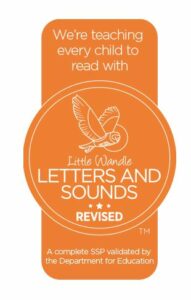What is Phonics?
“Phonics is a way of teaching children to read quickly and skillfully. They are taught how to recognise the sounds that each individual letter makes and identify the sounds that different combinations of letters make. Children can then use this knowledge to ‘de-code’ new words that they hear or see. This is the first important step in learning to read.” DFE ‘Information for Parents’ 2013
Phonics is a way of teaching children to read quickly and skillfully. They are taught how to:
* Recognise the sounds that individual letters make
* Identify the sounds that different combinations of letters make-such as ‘sh’ or ‘oo’
* Blend these sounds together from left to right to make a word
Written language can be compared to a code, so knowing the sounds of individual letters and how those letters sound when they’re combined will help children ‘decode’ new words that they hear or see. This is the first important step in learning to read.
The children are taught to read words by blending, which means pushing all the sounds together to make a word. The children are taught to spell words by segmenting, which means sounding out words and writing down the sounds they can hear.
Phonics in the Early Years Little Wandle
Teaching of Phonics at Knypersley
We ensure that children progress in their phonic knowledge through:
- Daily phonic sessions
- Phonics being promoted as a tool to help children decode words to read and spell
- Children being encouraged to use and apply their phonic knowledge in independent work,
guided writing sessions and individual or group reading where appropriate - Regular assessments which are then used to inform planning and cover gaps
- Clear, high expectations and time scales are set within our progression of phonics - interventions are put into place for those children not meeting the set milestones
- Reading books support and are closely matched to each child's phonological awareness and level of development

At Knypersley First School we follow the Little Wandle Letters and Sounds phonics and early reading scheme. Learning to become a reader is a very important aspect our little ones lives. By working together, consistently and with enthusiasm we can all make a huge difference in the development and progress of reading!
Please click the link below to read the information shared at our two Little Wandle parent sessions
LS-PowerPoint-for-parents-presentation-October-2022
Below you will find many resources that we encourage you to use to support your child with early reading and phonics at home.
Programme-Overview_Reception-and-Year-1-1
Why reading to your child really matters-
Everybody-read-leaflet-for-parents
The resources on the web page below will help you to support your child with saying their sounds and writing their letters. There are also some useful videos so you can see how they are taught at school and feel confident about supporting their reading at home.
Reception Autumn 1 Pronunciation Guide
Reception pronunciation guide autumn 2
Assessment
Children’s progress is continually reviewed to ensure that children stay on track to meet the milestone expectations in phonics. Children are formally assessed at the end of each half term.
The national Phonics screening check is performed in June of Year 1. Prior to this, the Year 1 phonics workshop gives parents information about how they can support their children at home with phonics. The purpose of the screening check is to confirm that all children have learned phonic decoding to an age-appropriate standard. The children who do not meet the required standard for the check in year 1 enter again in year 2. As children enter KS2, provision is made for those children still requiring daily phonics.
So, you now know there is Year 1 Phonics Screening Check, but what is it? How is it scored? And, perhaps most importantly, how can we as parents/carers help our children prepare for it?
